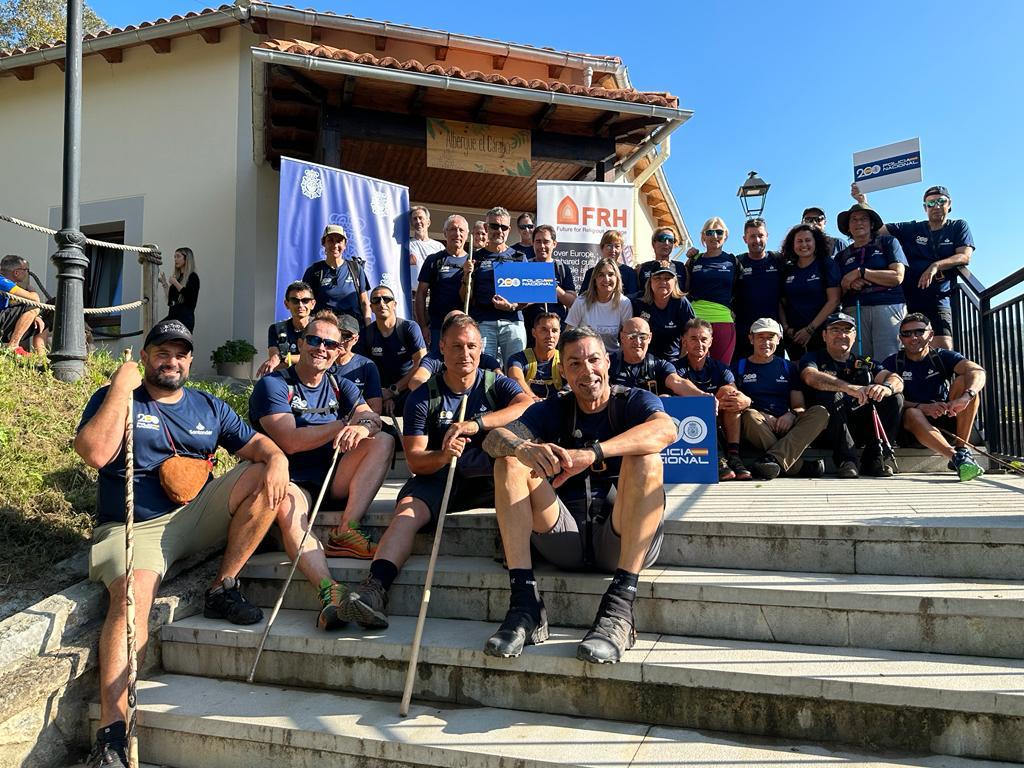
FRH and the Centre of Lebaniego Studies in Cades, with the police officers that are walking the Camino Lebaniego this weekend.
Brussels, 6 Ocotober 2023 – Future for Religious Heritage (FRH) and its member the Centre of Lebaniego Studies (Centro de Estudios Lebaniégos) applaud the decision of the National Police Corps in Cantabria, Spain, to celebrate the bicentennial of its creation by walking the Camino Lebaniego, one of the most important pilgrimage routes in Spain, recognised as a UNESCO World Heritage Site in 2015 and home to an extensive and significant religious heritage.
The event, which also coincides with the celebration of the Lebaniego Jubilee Year 2023, will take a group of 30 pilgrims, all of them National Police officers, on a journey through an ancient pilgrimage full of Romanesque and Gothic architectonic jewels, deep-rooted traditions, religious art and spectacular natural scenery. In addition to the pilgrims, the event expects to gather about 200 people on arrival at the Monastery of Santo Toribio, including about 50 children of different ages, to celebrate the cultural and natural richness of the Camino Lebaniego.
Pilgrims will start their journey on 6 October from San Vicente de la Barquera, a picturesque village on the shores of the Cantabrian Sea, travelling along the spectacular Senda del Nansa to Cades, where the first stage ends.
On 7 October, the second day, the route will continue from Cades through Cicera to the Mozarabic church of Santa María de Lebeña. This stage is the longest and most physically demanding of the pilgrimage, but also the most picturesque, as it runs mainly through Cantabrian mountain scenery and crosses two mountain passes: Collado de Hoz and Canal de los Francos.
Finally, on 8 October, pilgrims are expected to arrive at the Monastery of Santo Toribio de Liébana, thus completing the Jubilee. This sacred place has housed for centuries the largest fragment of the Cross recognised by the Catholic Church.
During this stage, the police officers will walk along the historic Camino Alto, which runs between the towns of Lebeña and Castro. This initiative aims to preserve this variant of the Camino Lebaniego, tougher for the pilgrims, but closely linked to the history of the Liébana region. After crossing the river Deva they will arrive at the village of Tama where they will also take the old Campañana road. On their way through Potes, after getting their stamp at the Pilgrim’s Office, they will be joined by the rest of their colleagues and the public who will be waiting for them to reach the end of this secular pilgrimage and cross the Puerta del Perdón together.
The Camino Lebaniego
The Camino Lebaniego is mentioned as early as the Middle Ages as a pilgrimage route to the Monastery of Santo Toribio de Liébana. The monastery has been of great importance since ancient times, when the Lignum Crucis (the name given to the piece of wood of the True Cross) was brought from Jerusalem to Astorga, and then transferred together with the relics of Santo Toribio to the monastery. The first stage of the Camino Lebaniego also merges with another of the most famous pilgrimage routes in Spain, the Camino del Norte, one of the earliest ways of the Camino de Santiago.





Follow us: